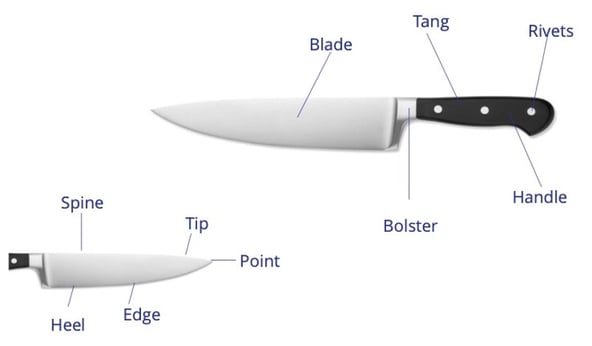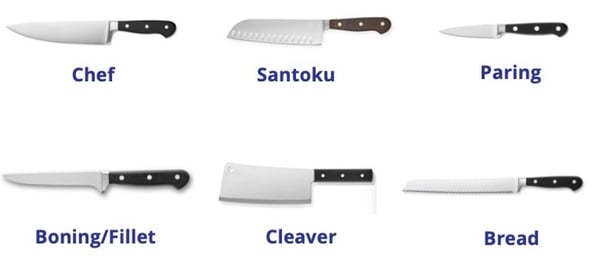It's important to have the right tools for the job. That's especially true in the kitchen! Here's a handy reference sheet to help you choose the right knife, adapted from our 30-Day Cooking Skills Challenge.
A quality kitchen knife can be your best tool in the kitchen. It’s important to get to know your knives so they can be used efficiently. You also want to ensure you’re selecting the right knife for your needs.
Anatomy of a Knife

- Blade The flat metal part of the knife that does the actual cutting. The sharp side is referred to as the edge with the flat side is the spine. At the top quarter of the blade, you’ll find the tip, where most of the cutting takes place, and at the foremost section is the point (good for piercing). At the tail end of the blade is the heel. This section is for when you need extra force.
- Bolster Between the blade and handle. It’s a thicker part in the metalwork that serves a couple of purposes. Its main function is to provide strength and reinforcement for the blade and balance the knife. It also helps prevent finger slippage when you’re cutting.
- Tang Tail of the blade. You don’t see it because it is extended into the handle. There are full tangs that are the same length as the handle held in by rivets and partial tangs that aren’t as long. The tang keeps the blade secured to the handle.
- Edge The sharpest part of the knife is the edge.
- Heel The heel is the bottom quarter of a blade. This part is emphasized when more force needs to be applied.
- Point This is the very top of the blade used for piercing.
- Spine This is the non-sharp piece of the blade.
- Tip It's the front quarter of the knife. Common cutting techniques use a rocking motion from tip to heel.
Types of Knives

- Chef knife is the ultimate knife in the kitchen. It is the only knife you actually need. Chef knives are all-purpose. They vary in size from 6-14” and can slice, dice, and chop any ingredient.
- Santoku knife is very much like a chef knife. It’s a light knife that is great for general use. The main difference between this and a chef knife is the shape of the blade. While a chef knife is a very straight knife, the santoku curves at the top half of the blade.
- Paring knives are very small. They’re perfect for peeling and segmenting. Since these blades are quite small, they are better for intricate work than a larger knife.
- Boning / Filet knives are meant for aiding in meat fabrication. The narrow blade can work closely with bones and joints. The Boning knife also is used for meats and seafood. What makes it unique is the blade's flexibility, which allows it to get a neat fillet on fish.
- Cleavers are sturdy and mainly for butchering. You can find small cleavers (aka Chinese cleavers) that most use for slicing or chopping.
- Bread knives have a serrated edge. This type of edge allows you to make slices through bread without crushing or crumbles. This is also handy on delicate foods like tomatoes or foods that may be tougher to cut through like watermelon or winter squash.
Culinary Resources
Want to learn more or practice your knife skills? Check out these resources
- Culinary Nutrition Studio
- Master Class
- Check out your local grocery stores, markets, restaurants, or culinary retail stores for hands-on classes
References & image credit: Culinary Nutrition Studio (culinarynutritionstudio.com)
Related Blog Posts
View All Blog Posts
Corporate Wellness Blogs
7 min read
| September 19, 2020
Get To Know Your Gadgets
Read More
Cooking Demo
3 min read
| September 13, 2024
The Power of Food & Community: Learning to Cook Together
Read More
Sweet Treats
2 min read
| November 14, 2023

